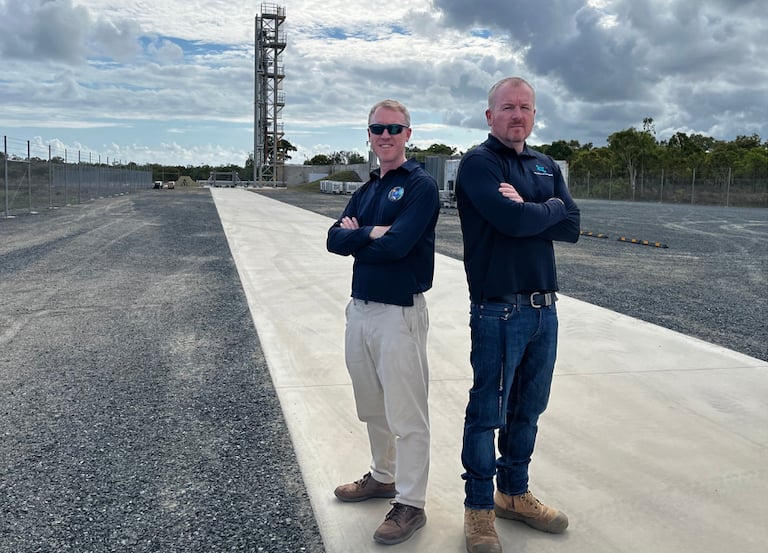Bowen, we have lift off.
In the end Gilmour Space’s 23-metre-high, 30-tonne orbital rocket didn’t rise more than 100-metres in the air before crashing after 14 seconds of flight, but finally, after several attempts, the Australian-designed and made rocket took off just after 8.30am, AEST.
“Got off the pad , I am happy. Of course I would have liked more flight time but happy with this,” the rocket company’s eponymous cofounder and CEO, Adam Gilmour, said on LinkedIn.
As Elon Musk’s SpaceX knows all too well, following several recent explosions of its Starship, getting a new rocket into the air is a huge challenge.
The Eris Rocket take off on test flight 1. Image: Gilmour Space
“Clearing the tower was a major milestone for our team. It showed that Australia can design, build, and launch rockets right here at home,” Gilmour said.
Footage of the launch shows the rocket taking off, rising about 100 metres in the air before falling back to earth, with Josh Keegan, aka Aussienaut commenting as he filmed the launch that the rocket didn’t have enough thrust to take to the skies. A couple of minutes later, a boom heard kilometres away signalled the explosion of the rocket, filling the rural landscape with a white cloud plume.
Adam Gilmour said their were no injuries to anyone and no adverse environmental impacts.
“Only six nations currently launch to orbit regularly — and just a handful are developing sovereign capability to join them,” he said.
“We’ve now taken a big step toward joining that group.”
You can watch Keegan’s footage here – the liftoff occurs around 1 hr 32 mins into his broadcast. There was a jar of Vegemite aboard the Eris rocket as a symbolic payload on its maiden flight.

Gilmour Space’s Eris rocket at the Bowen Orbital Spaceport.
“Space is hard,” said Adam Gilmour, following the launch.
“SpaceX, Rocket Lab and others needed multiple test flights to reach orbit. We’ve learned a tremendous amount that will go directly into improving our next vehicle, which is already in production.
“Getting off the pad and into flight is a huge step forward for any new rocket program. This was the first real test of our rocket systems, our propulsion technology, and our spaceport — and it proved that much of what we’ve built works.”
The Eris Block 1 rocket is a three-stage orbital launch vehicle designed to carry small satellites to orbit. Gold Coast-based Gilmour Space was founded in 2013, and has grown to more than 200 employees. The company also built a launchpad in northern Queensland at Bowen, 200km from Townsville. Yesterday, when the latest of several launch windows opened, the company got to T-10 minutes to launch before scrubbing the test flight when high-altitude winds stayed above the safety commit limits set by regulators.
Gilmour’s Eris rocket uses proprietary hybrid-propellant technology that’s safer and cheaper than traditional liquid- and solid-fuelled rockets. In that respect, the crash is better for the environment than alternative propulsion methods
When successful, it could be the world’s first hybrid-propelled rocket to achieve orbit, as well as giving Australia sovereign capability.
The startup has attempted several launches this year, since finally receiving regulatory approval for a test flight in late 2024, but poor weather and technical issues caused delays until today.
The spacetech startup has raised $142 million in venture funding, including $19 million Series B in 2018 and $61 million in a Series C in June 2021 and earlier this year, a $55 million Series D, as well as attracting tens of millions in funding from local, state and federal governments.

The Eris Rocket lifts off from north Qld on July 30. Image: Gilmour Space
Swinburne’s codirector of the Space Technology and Industry Institute, Dr Rebecca Allen, said the rocket was not intended to reach orbit.
“The test provided valuable data for the team as they prepare the vehicle to be Australia’s ticket to Low Earth Orbit,” she said.
Gilmour Sapce said initial data confirms that key systems performed well until the anomaly, including ignition, liftoff, first-stage thrust, range tracking and telemetry. The team is now reviewing flight data to understand the cause of the anomaly that led to early termination, with lessons already being applied to the next vehicle, which is in production.
The team will now review flight data and apply lessons learned to the next Eris rocket, with plans to launch again in the coming months.
“Every test, especially the first, is a learning opportunity,” said Gilmour.
“Congratulations to our talented team for getting us this far. Onward to TestFlight 2.”

Gilmour Space cofounders Adam and James Gilmour, at the Bowen Orbital Spaceport just as the build got underway.



